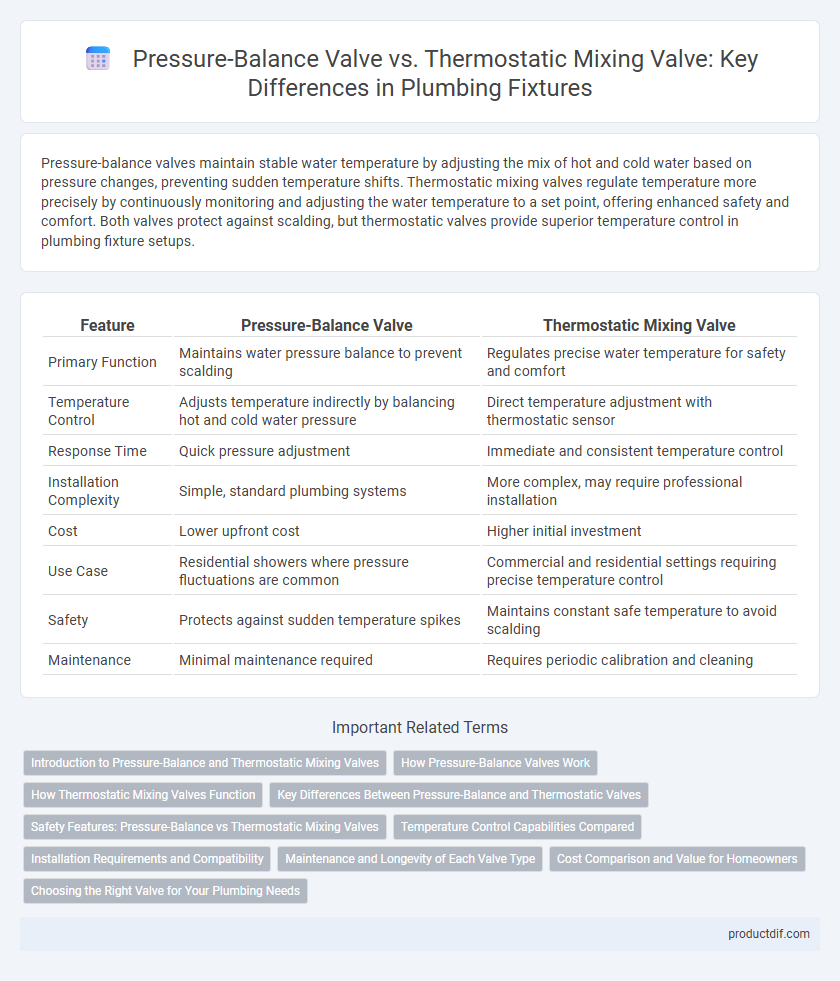Pressure-balance valves maintain stable water temperature by adjusting the mix of hot and cold water based on pressure changes, preventing sudden temperature shifts. Thermostatic mixing valves regulate temperature more precisely by continuously monitoring and adjusting the water temperature to a set point, offering enhanced safety and comfort. Both valves protect against scalding, but thermostatic valves provide superior temperature control in plumbing fixture setups.
Table of Comparison
| Feature | Pressure-Balance Valve | Thermostatic Mixing Valve |
|---|---|---|
| Primary Function | Maintains water pressure balance to prevent scalding | Regulates precise water temperature for safety and comfort |
| Temperature Control | Adjusts temperature indirectly by balancing hot and cold water pressure | Direct temperature adjustment with thermostatic sensor |
| Response Time | Quick pressure adjustment | Immediate and consistent temperature control |
| Installation Complexity | Simple, standard plumbing systems | More complex, may require professional installation |
| Cost | Lower upfront cost | Higher initial investment |
| Use Case | Residential showers where pressure fluctuations are common | Commercial and residential settings requiring precise temperature control |
| Safety | Protects against sudden temperature spikes | Maintains constant safe temperature to avoid scalding |
| Maintenance | Minimal maintenance required | Requires periodic calibration and cleaning |
Introduction to Pressure-Balance and Thermostatic Mixing Valves
Pressure-balance valves regulate water temperature by adjusting pressure fluctuations in the hot and cold water supply, preventing sudden temperature changes during usage. Thermostatic mixing valves maintain a consistent water temperature by automatically blending hot and cold water to a pre-set level, offering precise thermal control. Both valves are essential in plumbing fixtures for enhancing safety and comfort, with pressure-balance valves primarily protecting against scalding from pressure drops and thermostatic valves providing stable, customized temperature settings.
How Pressure-Balance Valves Work
Pressure-balance valves maintain consistent water temperature by automatically adjusting the hot and cold water pressures in response to fluctuations, preventing sudden temperature changes that can cause scalding or thermal shock. These valves use a diaphragm or piston mechanism that senses pressure imbalances and shifts to equalize the flow rates of hot and cold water. Commonly used in shower systems, pressure-balance valves enhance safety and comfort by stabilizing temperature during operation without requiring manual adjustments.
How Thermostatic Mixing Valves Function
Thermostatic mixing valves function by blending hot and cold water to maintain a consistent outlet temperature, preventing sudden temperature fluctuations that can cause scalding. They contain a thermostatic element that expands or contracts in response to temperature changes, automatically adjusting the mix of water to maintain the set temperature. These valves provide precise temperature control, enhancing safety and comfort in residential and commercial plumbing fixtures.
Key Differences Between Pressure-Balance and Thermostatic Valves
Pressure-balance valves regulate water temperature by adjusting the pressure of hot and cold water to prevent sudden temperature changes, primarily protecting against scalding during pressure fluctuations. Thermostatic mixing valves maintain a set temperature by actively mixing hot and cold water, offering more precise and consistent temperature control even with varying water pressures. The key difference lies in temperature regulation accuracy and response: pressure-balance valves react to pressure changes, while thermostatic valves maintain steady temperature regardless of pressure shifts.
Safety Features: Pressure-Balance vs Thermostatic Mixing Valves
Pressure-balance valves quickly adjust to changes in water pressure to prevent sudden temperature fluctuations, reducing the risk of scalding during showers. Thermostatic mixing valves maintain a consistent water temperature by automatically adjusting the mix of hot and cold water, offering enhanced precision and safety. Both valve types are essential for protecting users from burns, but thermostatic valves provide superior control in settings requiring exact temperature regulation.
Temperature Control Capabilities Compared
Pressure-balance valves regulate water temperature by adjusting the pressure of hot and cold water to prevent sudden changes, offering basic protection against scalding. Thermostatic mixing valves provide precise temperature control by continuously mixing hot and cold water to maintain a consistent set temperature, enhancing user comfort and safety. Unlike pressure-balance valves, thermostatic valves quickly respond to temperature fluctuations and maintain accuracy within one degree Fahrenheit.
Installation Requirements and Compatibility
Pressure-balance valves require straightforward installation with two water supply lines and are compatible with most standard plumbing systems due to their simple mechanical design. Thermostatic mixing valves demand more precise installation, often involving dedicated thermostatic cartridges and integration with compatible temperature control systems to ensure accurate temperature regulation. Compatibility with modern plumbing setups varies, with thermostatic valves frequently preferred for high-end or commercial applications requiring strict temperature control and safety compliance.
Maintenance and Longevity of Each Valve Type
Pressure-balance valves typically require routine maintenance to clean or replace internal cartridges to prevent mineral buildup and ensure consistent water pressure regulation. Thermostatic mixing valves, designed with more complex temperature-sensitive components, often demand specialized servicing but provide greater long-term performance stability in maintaining precise water temperatures. Both valve types benefit from periodic inspection to prolong longevity, with thermostatic valves generally offering enhanced durability in environments with fluctuating water temperatures.
Cost Comparison and Value for Homeowners
Pressure-balance valves generally cost less upfront, ranging from $30 to $100, making them a budget-friendly option for basic temperature control in plumbing fixtures. Thermostatic mixing valves, priced between $100 and $300, offer precise temperature regulation and enhanced safety, providing greater long-term value by reducing the risk of scalding and improving water efficiency. Homeowners seeking durability and consistent comfort may find the higher initial investment in thermostatic valves justified by their advanced features and energy savings.
Choosing the Right Valve for Your Plumbing Needs
Pressure-balance valves maintain consistent water pressure by adjusting hot and cold water flow to prevent sudden temperature changes, making them ideal for shower systems prone to pressure fluctuations. Thermostatic mixing valves precisely regulate water temperature by blending hot and cold water, ensuring a stable output even with varying supply conditions, suitable for installations requiring exact temperature control. Selecting the right valve depends on whether your priority is pressure stability or precise temperature regulation in your plumbing fixtures.
pressure-balance valve vs thermostatic mixing valve Infographic

 productdif.com
productdif.com